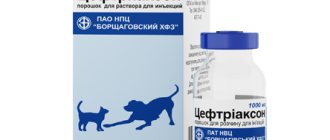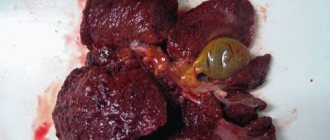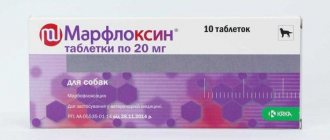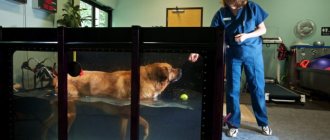Types of analyzes and their indicators
Biological material is examined clinically and biochemically. The first study examines changes within cells, and the second identifies disorders within organs and systems.
General (clinical)
A general or clinical blood test (CBC) in dogs determines the condition of the body and reveals the presence of blood parasites that destroy red blood cells. After studying the biomaterial, the laboratory assistant creates a hemogram - a detailed table demonstrating the level of basic indicators. These include:
- Red blood cells
. They make up the majority of cells. Responsible for the circulation of oxygen and carbon dioxide.
- Hemoglobin
. An iron-containing protein found in red blood cells. Performs a similar transport function.
- Erythrocyte sedimentation rate (ESR)
. Determines the presence of a disease that prevents the natural settling of cells under the influence of gravity.
- Hematocrit
. Evaluates the ability of the transport function of red blood cells. It is calculated as the ratio of blood cells to the entire blood mass, that is, it determines the density.
- Mean hemoglobin content in erythrocytes (MCH)
. Takes into account the color intensity of red blood cells, determining possible anemia.
- Color index
. Similar to MCH, but expressed in relative rather than absolute terms.
- Reticulocytes
. Immature red blood cells, comprising up to 1% of their adult relatives. They talk about illness in their absence.
- Platelets
. They are responsible for timely clotting, blocking bleeding.
- Myelocytes
. White blood cells contained in the soft tissues of the internal cavity of bones. Their appearance in plasma indicates a pathological condition.
- Plasmocytes
. They are responsible for the creation of immunoglobulins - protective proteins that attack foreign microorganisms. Absent in a healthy state.
- Leukocytes
. Another white blood cell that performs a protective function.
If infection or parasites are suspected, a detailed study of leukocytes is performed. When a foreign agent is detected, several types of these cells come into play: eosinophils, lymphocytes, neutrophils, basophils and monocytes.
Biochemical
Biochemistry, or BAC, identifies the affected organ or system even with hidden pathologies. The procedure is often performed for preventive purposes. Basic indicators include:
- Glucose
. A universal source of energy that supports metabolic processes.
- Urea
. Released by decaying proteins. Used to determine if there is a kidney problem.
- Creatinine
. A substance formed in the muscles and completely excreted from the body along with urine. Together with urea, it helps to understand the condition of the kidneys.
- Total and direct bilirubin
. It is synthesized from decaying hemoglobin, which may or may not have passed through the liver.
- Cholesterol and total lipids
. Regulate cell permeability and protect against hemolytic poisons.
- Acid and alkaline phosphatase
. Contained in hepatocytes, platelets, red blood cells, intestines, liver, bone and placental tissues.
- Gamma-glutamyl transpeptidase
. Liver protein analyzed in conjunction with alkaline phosphatase.
- Creatine kinase
. An enzyme consumed by the body during intense exercise.
- Acid-base balance (pH)
. An important parameter that causes serious disruptions in the body at the slightest deviation.
- Total protein and serum albumin
. Reflect the state of protein metabolism. Proteins perform a construction function and maintain tissue elasticity.
- ALT and AST
. The most important enzymes responsible for the metabolism of amino acids. Found in the heart, brain and skeletal muscles.
- Triglycerides
. The main nutritional component responsible for the body's energy reserves.
- Lipase
. Responsible for dissolving fats and transporting them to tissues.
- Alpha amylase
. Responsible for the breakdown of carbohydrates.
- Lactate dehydrogenase
. Responsible for the breakdown of glucose.
In addition to the listed compounds, electrolytes play an important role: calcium, sodium, chlorine, potassium, phosphorus, magnesium. They are responsible for the electrical balance that ensures the uninterrupted transmission of nerve signals to the cerebral cortex.
Disorders of mineral metabolism in puppies and young dogs
Excess calcium. Owners of large breed puppies often overdose on calcium, thinking they are doing the right thing. Excess calcium in the diet with a normal amount of vitamin D leads to metabolic disorders in the body, which interferes with the normal growth of the dog.
In this regard, the experiments conducted by Dr. Hazenwinkel are very indicative. He compares the development of Great Dane puppies fed different amounts of calcium in their diet: - 5 puppies received 1.1% calcium, - 6 puppies received 3.3% calcium.
Puppies receiving 3.3% calcium (excess) were stunted in growth, had poor appetite, and abnormal placement of their limbs due to bone deformation.
Excess calcium leads to impaired absorption of zinc, which can cause skin diseases.
In addition, an overdose of calcium causes hypertrophy of the gastric mucosa and pyloric atony - risk factors for volvulus in a dog.
Prevention: do not exceed the daily dosage of calcium (500 mg per 1 kg of puppy weight and 250 mg per 1 kg of adult dog weight).
Excess vitamin D (hypervitaminosis D). Of course, puppies and young dogs need vitamin D and minerals in the correct proportions for normal development of the body, prevention of rickets and osteofibrosis. Dogs cannot produce vitamin D on their own when exposed to ultraviolet rays, so it must be added to their food. However, it must be borne in mind that hypervitaminosis D is even more dangerous than hypovitaminosis.
A dose exceeding 100 units per 1 kg of dog weight is risky.
Treatment: changes in the body are most often irreversible. Treatment can only stop the process, but not correct bone deformities. Reduce the dosage of vitamin D and calcium, and prescribe calciotonin. Surgery is sometimes indicated, especially to correct forelimb deformities.
Prevention: do not overdose on vitamin D, calcium and do not overfeed the dog.
Excess vitamin D combined with calcium deficiency. It aggravates pathological changes caused by calcium deficiency, provoking severe demineralization of bones and, as a result, curvature of the limbs, lameness, and fractures.
Excess vitamin D combined with excess calcium. Leads to excessive bone mineralization, which results in hypertrophic osteodystrophy.
Signs: depressed state, loss of appetite, fever, pain in the joints, causing lameness, often - refusal of movement, symmetrical deformation of the joints, hot joints, “loose” paws.
X-ray studies reveal compaction of the metaphyses, mineralization of the epiphysis shell, which provokes slower growth and curvature of the bones. In more severe cases, calcium deposition is observed in large vessels, heart valves, bronchi, vocal cords, and kidneys.
Reasons: excess dosages of vitamin D and mineral supplements by overly caring owners of large dogs who are trying to prevent rickets in their pets; instead, the dog develops osteodystrophy.
Read the continuation in the magazine “Doberman”, 1/1995 Translation by Y. Pavlova, Consultant: Candidate of Biological Sciences T. Mareeva Doctor Charrier
Norms of indicators
The standards for clinical and biochemical blood tests in adult dogs and puppies are different. To correctly interpret the result, it is necessary to take into account the age of the animal.
In clinical tests
Most laboratories provide results not only of deviations, but also of norms. This allows you to assess the level of danger. The recommended values according to the UAC can be found in the table.
Absence of values is typical when the diagnostic value is low or the indicator is absent in a healthy body. A similar scheme applies to the LHC results.
In biochemical tests
Recommended BAC values are the same for all ages. The results typical for healthy animals can be found below.
After receiving the results by email or finding them in your personal account on the veterinary clinic’s website, you can try to decipher them yourself. This will help confirm or refute any concerns you may have before talking to your doctor. Despite the results obtained, remember that treatment is carried out only after consultation with a veterinarian.
Interpretation of blood test results
Decoding the results will tell you a lot about the dog’s health: you can detect inflammatory processes, bacterial or viral infection, the presence of parasites, and cancer.
Clinical blood test
UAC decoding table:
| Index | What does it mean if downgraded? | What does it mean if it's elevated? |
| Hematocrit | Anemia | dehydration of the body; leukemia |
| Hb | anemia; bleeding. | dehydration; blood diseases. |
| Red blood cells | anemia; bleeding. | leukemia; heart diseases. |
| ESR | epilepsy; erythrocytosis; reaction to the introduction of calcium chloride. | tissue necrosis; infectious diseases; parasites; reaction to stress; poisoning; neoplasms; injuries; postoperative period; pregnancy. |
| Leukocytes | diseases caused by viruses and bacteria; allergy; presence of metastases; response to therapy with anticonvulsants, sulfonamides. | necrosis; bacterial infections; poisoning; malignant tumors. |
| Band neutrophils (granulocytes) | pathologies occurring in a chronic form (may not have symptoms); genetic abnormalities; diseases of a viral nature. | the beginning of the inflammatory process; poisoning; stress suffered by the animal. |
| Eosinophils | *indicators are not important for diagnosis | allergy; damage to the body by parasites; myeloid leukemia. |
| Basophils | *indicators are not important for diagnosis | allergy; chronic inflammatory processes in the gastrointestinal tract; leukemia |
| Lymphocytes | neoplasms; treatment with corticosteroids; kidney and liver diseases. | viral infections; treatment with NSAIDs; toxoplasmosis. |
| Monocytes | Long-term treatment with hormonal medications | infections; piroplasmosis; tuberculosis is one of the causes of monocytosis; colitis. |
| Myelocytes | *not normally detected | sepsis; severe stress; inflammatory processes in the body; myeloid leukemia; copious blood loss. |
| Reticulocytes | The main reason is anemia. | Hypoxia most often causes an increase in the indicator. |
| Plasmocytes | *not normally detected | severe viral infections; tumors; tuberculosis. |
| Platelets | Long-term treatment with antibiotics and diuretics. | leukemia; postoperative period; treatment with corticosteroids. |
What deviations from the norm may mean
To decipher a blood test in dogs, the difference between the norm and the resulting deviation is used. Self-diagnosis is complicated by an integrated approach to interpretation. It will not be possible to determine the disease by just one of the deviations.
Possible results depend on which direction the value deviates. It can cross the upper or lower boundary.
In clinical analysis
Small deviations within one tenth or even whole values are acceptable. This can be explained by an error in collecting material, improper preparation of the dog, or other reasons.
Serious pathology is indicated when the indicator differs too much. Possible diagnoses can be found below.
| Name | Below normal | Above normal |
| Red blood cells |
|
|
| Hemoglobin |
|
|
| ESR |
|
|
| Hematocrit |
|
|
| Reticulocytes |
|
|
| Platelets |
|
|
| Myelocytes | — |
|
| Plasmocytes | — |
|
| Leukocytes |
|
|
| Eosinophils | — |
|
| Lymphocytes |
|
|
| Neutrophils |
|
|
| Basophils | — |
|
| Monocytes |
|
|
The MCH and color score are used to determine the severity of the suspected disease. They are not considered outside of hemoglobin and red blood cells.
In biochemical analysis
During diagnosis, the veterinarian compares the hemograms of both studies. Possible deviations in the LHC are presented below.
| Name | Below normal | Above normal |
| Glucose |
|
|
| Urea |
|
|
| Creatinine |
|
|
| Total bilirubin | — |
|
| Direct bilirubin | — |
|
| Cholesterol |
|
|
| General lipids | — |
|
| Acid phosphatase | — |
|
| Alkaline phosphatase |
|
|
| Gamma-glutamyl transpeptidase | — |
|
| Creatine kinase | — |
|
| pH |
|
|
| Total protein |
|
|
| Serum albumin |
|
|
| ALT | — |
|
| AST |
|
|
| Triglycerides |
|
|
| Lipase |
|
|
| Alpha amylase |
|
|
| Lactate dehydrogenase | — |
|
| Calcium |
|
|
| Sodium |
|
|
| Chlorine |
|
|
| Potassium |
|
|
| Phosphorus |
|
|
| Magnesium |
|
|
To obtain reliable indicators, the owner needs to prepare the animal in advance. Restrictions are imposed on physical activity, nutrition and medication.
LiveInternetLiveInternet
based on materials from https://vetvrach.info/biohimiya.html
Hemogram of dogs of different ages and sexes (RW Kirk)
| floor | up to 12 months | 1-7 years | 7 years and older | ||||
| oscillation | Wed meaning | oscillation | Wed meaning | oscillation | Wed meaning | ||
| red blood cells (million/µl) | male | 2,99-8,52 | 5,09 | 5,26-6,57 | 5,92 | 3,33-7,76 | 5,28 |
| female | 2,76-8,42 | 5,06 | 5,13-8,6 | 6,47 | 3,34-9,19 | 5,17 | |
| hemoglobin (g/dl) | male | 6,9-16,5 | 10,7 | 12,7-16,3 | 15,5 | 14,721,2 | 17,9 |
| female | 6,4-18,9 | 11,2 | 11,5-17,9 | 14,7 | 11,0-22,5 | 16,1 | |
| leukocytes (thousand µl) | male | 9,9-27,7 | 17,1 | 8,3-19,5 | 11,9 | 7,9-35,3 | 15,5 |
| female | 8,8-26,8 | 15,9 | 7,5-17,5 | 11,5 | 5,2-34,0 | 13,4 | |
| mature neutrophils (%) | male | 63-73 | 68 | 65-73 | 69 | 55-80 | 66 |
| female | 64-74 | 69 | 58-76 | 67 | 40-80 | 64 | |
| lymphocytes (%) | male | 18-30 | 24 | 9-26 | 18 | 15-40 | 29 |
| female | 13-28 | 21 | 11-29 | 20 | 13-45 | 29 | |
| monocytes (%) | male | 1-10 | 6 | 2-10 | 6 | 0-4 | 1 |
| female | 1-10 | 7 | 0-10 | 5 | 0-4 | 1 | |
| eosinophils (%) | male | 2-11 | 3 | 1-8 | 4 | 1-11 | 4 |
| female | 1-9 | 5 | 1-10 | 6 | 0-19 | 6 | |
| platelets x 109/l | 200-500 | 350 | |||||
Hemogram of cats of different ages and sex (RW Kirk)
male female[/td]
| floor | up to 12 months | 1-7 years | 7 years and older | ||||
| oscillation | Wed meaning | oscillation | Wed meaning | oscillation | Wed meaning | ||
| red blood cells (million/µl) | 5,43-10,22 4,46-11,34 | 6,96 6,90 | 4,48-10,27 4,45-9,42 | 7,34 6,17 | 5,26-8,89 4,10-7,38 | 6,79 5,84 | |
| hemoglobin (g/dl) | male female | 6,0-12,9 6,0-15,0 | 9,9 9,9 | 8,9-17,0 7,9-15,5 | 12,9 10,3 | 9,0-14,5 7,5-13,7 | 11,8 10,3 |
| leukocytes (thousand µl) | male female | 7,8-25,0 11,0-26,9 | 15,8 17,7 | 9,1-28,2 13,7-23,7 | 15,1 19,9 | 6,4-30,4 5,2-30,1 | 17,6 14,8 |
| mature neutrophils (%) | male female | 16-75 51-83 | 60 69 | 37-92 42-93 | 65 69 | 33-75 25-89 | 61 71 |
| lymphocytes (%) | male female | 10-81 8-37 | 30 23 | 7-48 12-58 | 23 30 | 16-54 9-63 | 30 22 |
| monocytes (%) | male female | 1-5 0-7 | 2 2 | 1-5 0-5 | 2 2 | 0-2 0-4 | 1 1 |
| eosinophils (%) | male female | 2-21 0-15 | 8 6 | 1-22 0-13 | 7 5 | 1-15 0-15 | 8 6 |
| platelets (x 109/l) | 300-700 | 500 | |||||
Biochemical blood test. Interpretation of biochemical results. (based on materials from https://vetvrach.info/)
Enzymes.
Enzymes are the main biological catalysts, i.e. substances of natural origin that accelerate chemical reactions. Also, enzymes take part in the regulation of many metabolic processes, thereby ensuring that metabolism corresponds to changed conditions. Almost all enzymes are proteins. Depending on reaction and substrate specificity, six main classes of enzymes are distinguished (oxireductases, transferases, hydrolases, lyases, isomerases and ligases). In total, more than 2000 enzymes are currently known. The catalytic action of the enzyme, i.e. its activity is determined under standard conditions by the increase in the rate of the catalytic reaction compared to the non-catalytic reaction. The rate of a reaction is usually reported as the change in substrate or product concentration per unit time (mmol/L per second). Another unit of activity is the International Unit (IU), the amount of enzyme that converts 1 µmol of substrate in 1 minute.
The following enzymes are of primary clinical importance: Aspartate aminotransferase (AST, AST)
An intracellular enzyme involved in amino acid metabolism. It is found in high concentrations in the liver, heart, skeletal muscles, brain, and red blood cells. Released when tissue is damaged.
Reference intervals:
for dogs – 11 – 42 units;
for cats – 9 – 29 Units.
for horses – 130 – 300 units.
Increased: Necrosis of liver cells of any etiology, acute and chronic hepatitis, necrosis of the heart muscle, necrosis or injury of skeletal muscles, fatty liver, damage to brain tissue, kidneys; use of anticoagulants, vitamin C
Reduced: Has no diagnostic value (rarely with a lack of pyridoxine (Vitamin B6).
ALANINE AMINOTRANSFERASE (ALT, ALT)
An intracellular enzyme involved in amino acid metabolism. It is found in high concentrations in the liver, kidneys, muscles - in the heart and skeletal muscles. Released when tissue is damaged, especially when the liver is damaged.
Reference intervals:
for dogs – 9 – 52 Units;
for cats – 19 – 79 Units.
for horses – 2.7 – 20.0 units;
Increased: Cell necrosis, acute and chronic hepatitis, cholangitis, fatty liver, liver tumors, use of anticoagulants
Decreased: Has no diagnostic value
creatine phosphokinase (CPK, CK)
CK consists of three isoenzymes, consisting of two subunits, M and B. Skeletal muscles are represented by the MM isoenzyme (CPK-MM), the brain - by the BB isoenzyme (CPK-BB), the myocardium contains about 40% of the MB isoenzyme (CPK-MB).
Reference intervals:
for dogs – 32 – 157 units;
for cats – 150 – 798 units.
for horses – 50 – 300 units.
in young animals during the growth period, LDH activity increases 2–3 times.
Increased: Myocardial infarction (2-24 hours; CPK-MB is highly specific). Trauma, surgery, myocarditis, muscular dystrophy, polymyositis, convulsions, infections, embolism, heavy physical activity, damage to brain tissue, cerebral hemorrhage, anesthesia, poisoning (including sleeping pills), coma, Reye's syndrome. Slight increase in congestive heart failure, tachycardia, arthritis.
Decreased: Has no diagnostic value.
gamma glutamyl transferase (GGT)
GGT is present in the liver, kidneys, and pancreas. The test is extremely sensitive for liver diseases. A high GGT value is used to confirm the hepatic origin of serum alkaline phosphatase activity.
Reference intervals:
for dogs – 1 – 10 units;
for cats – 1 – 10 units.
for horses – 1 – 20 units.
Increased: Hepatitis, cholestasis, tumors and cirrhosis of the liver, pancreas, post-infarction period;
Decreased: Has no diagnostic value.
lactate dehydrogenase (LDH)
LDH is an enzyme that catalyzes the internal conversion of lactate and pyruvate in the presence of NAD/NADH. Widely distributed in cells and body fluids. It increases with tissue destruction (artificially increases with hemolysis of red blood cells due to improper collection and storage of blood). Presented by five isoenzymes (LDH1 – LDH5)
Reference intervals:
for adult dogs – 23 – 164 units;
for adult cats – 55 – 155 units.
for adult horses – 100 – 400 units.
in young animals during the growth period, LDH activity increases 2–3 times.
Increased: Damage to myocardial tissue (2 – 7 days after the development of myocardial infarction), leukemia, necrotic processes, tumors, hepatitis, pancreatitis, nephritis, muscular dystrophy, damage to skeletal muscles, hemolytic anemia, circulatory failure, leptospirosis, feline infectious peritonitis.
Decreased: Has no diagnostic value
Cholinesterase (ChE)
ChE is found predominantly in blood serum, liver, and pancreas. ChE in blood plasma is an extracellular enzyme of glycoprotein nature, formed in the cells of the liver parenchyma.
Reference intervals:
dogs - from 2200 U/l
cats – from 2000 U/l
Increased: Has no diagnostic value.
Reduced: Subacute and chronic diseases and liver damage (due to impaired synthesis of ChE by hepatocytes), poisoning with organophosphorus compounds.
AMYLASE (DIASTASE)
Amylase hydrolyzes complex carbohydrates. Serum alpha-amylase originates primarily from the pancreas (pancreatic) and salivary glands, and enzyme activity increases with inflammation or obstruction. Other organs also have some amylase activity - the small and large intestines, skeletal muscles, and ovaries. In horses, amylase is represented mainly by the beta fraction.
Reference intervals:
for dogs (alpha-amylase) – 685 – 2155 units;
for cats (alpha-amylase) – 580 – 1720 units.
for horses (beta-amylase) – 4.9 – 16.5 units.
Increased: Pancreatitis, mumps, renal failure (acute and chronic), poisoning, diabetes mellitus, acute hepatitis, primary biliary cirrhosis of the liver, volvulus of the stomach and intestines, peritonitis, disturbance of electrolyte metabolism.
Decreased: Necrosis of the pancreas, thyrotoxicosis, poisoning with arsenic, barbiturates, carbon tetrachloride; use of anticoagulants.
alkaline phosphatase (ALP)
Alkaline phosphatase is found in the liver, bones, intestines and placenta. To differentiate the activity of alkaline phosphatase (liver or bones), the determination of GGT is used (increased in liver diseases, and unchanged in bone diseases).
Reference intervals:
for adult dogs – 18 – 70 units;
for adult cats – 39 – 55 units.
for adult horses – 70 – 250 units
in young animals during the growth period, the activity of alkaline phosphatase increases several times and is not an informative indicator.
Increased: Fracture healing, osteomalacia, bone tumors, cholangitis, Cushing's syndrome, bile duct obstruction, gallbladder tumors; abscess, cirrhosis, liver cancer, hepatitis, bacterial infections of the gastrointestinal tract, fatty foods, pregnancy.
Reduced: Hypothyroidism, anemia, hypovitaminosis C, use of corticosteroids.
Acid phosphatase (AF)
In males, 50% of serum CP comes from the prostate gland, and the rest from the liver and degrading platelets and red blood cells.
In females, CP is produced by the liver, red blood cells and platelets.
Reference intervals:
dogs - 1-6 U/l
cats – 1-6 U/l
Increased: Prostate carcinoma (in the initial stage of prostate cancer, CP activity may be within normal limits).
When prostate carcinoma metastases into bone tissue, alkaline phosphatase increases.
Prostate massage, catheterization, cystoscopy, rectal examinations lead to an increase in EF, so it is recommended to take blood for analysis no earlier than 48 hours after these procedures.
Decreased: Has no diagnostic value.
Lipase
Lipase is an enzyme that catalyzes the breakdown of glycerides of higher fatty acids. It is produced in the body by a number of organs and tissues, which makes it possible to distinguish between lipase of gastric origin, pancreas, lung lipase, intestinal juice, leukocytes, etc. Serum lipase is the sum of organ lipases, and an increase in its activity is a consequence of a pathological process in any organ. Fluctuations in serum lipase activity in a healthy animal are insignificant.
Reference intervals:
dogs - 30-250 U/l
cats – 30-400 U/l
Elevated: Acute pancreatitis (may be 200 times higher than normal) – lipase activity in the blood increases rapidly within a few hours after an attack of pancreatitis, reaching a maximum after 12-24 hours, and remains elevated for 10-12 days, t .e. longer time than the activity of β-amylase. In case of malignant neoplasm of the pancreas in the early stage of the disease.
Decreased: Stomach cancer (in the absence of metastases to the liver and pancreas), with a malignant neoplasm of the pancreas in a later period of the disease (as the gland tissue resolves).
Substrates and fats
Total bilirubin
Bilirubin is a product of hemoglobin metabolism and is conjugated in the liver with glucuronic acid to form mono- and diglucuronides secreted in the bile (direct bilirubin). Serum bilirubin levels increase with liver disease, biliary obstruction, or hemolysis. During hemolysis, unconjugated (indirect) bilirubin is formed, therefore, high total bilirubin will be observed with normal direct bilirubin.
Reference intervals:
for dogs – 3.0 – 13.5 mmol/l;
for cats – 3.0 – 12.0 mmol/l.
for horses – 5.4 – 51.4 mmol/l.
Increased: Damage to liver cells of various types, obstruction of the bile ducts, hemolysis
Decreased: Bone marrow diseases, anemia, hypoplasia, fibrosis
Direct bilirubin
Reference intervals:
for dogs – 0.0 – 5.5 mmol/l;
for cats – 0.0 – 5.5 mmol/l.
for horses – 0.0 – 10.0 mmol/l.
Increased: obstruction of the bile ducts, cholestasis, liver abscess, leptospirosis, chronic hepatitis
Decreased: has no diagnostic value.
Urea
Urea is formed in the liver as a result of neutralization of highly toxic ammonia formed as a result of bacterial fermentation in the gastrointestinal tract, deamination of amino acids, purine and pyrimidine bases, biogenic amines, etc. Excreted by the kidneys.
Reference intervals:
for dogs – 3.5 – 9.2 mmol/l;
for cats – 5.4 – 12.1 mmol/l.
for horses – 3.5 – 8.8 mmol/l;
Increased: Impaired kidney function (renal failure), protein-rich diet, acute hemolytic anemia, shock, stress, vomiting, diarrhea, acute myocardial infarction
Reduced: Low protein intake, severe liver disease
Creatinine
Creatinine is the end product of creatine metabolism, synthesized in the kidneys and liver from three amino acids (arginine, glycine, methionine). Creatinine is completely excreted from the body by the kidneys by glomerular filtration, without being reabsorbed in the renal tubules. This property of creatinine is used to study the level of glomerular filtration by creatinine clearance in urine and serum.
Reference intervals:
for dogs – 26.0 – 120.0 µmol/l;
for cats – 70.0 – 165.0 µmol/l.
for horses – 80.0 – 180.0 µmol/l.
Increased: Impaired renal function (renal failure), hyperthyroidism, use of furosemide, vitamin C, glucose, indomethacin, mannitol. Patients with diabetic ketoacidosis may have a falsely elevated creatinine level.
Decreased: Pregnancy, age-related decreases in muscle mass
Uric acid
Uric acid is the end product of purine metabolism. It is formed in the liver as a result of the breakdown of nucleotides, deamination of aminopurines and subsequent oxidation of oxypurines. Excreted from the body by the kidneys.
Reference intervals:
dogs - 9-100 µmol/l
cats - up to 150 µmol/l
Increased: Significantly - if there is a violation of the removal of uric acid from the body (kidney disease, urolithiasis, acidosis, toxicosis), gout is caused by an increase in the synthesis of uric acid. Insignificant - when eating food rich in purines (meat, liver, kidneys), certain hematological diseases (leukemia, B12-deficiency anemia), cellular cytolysis, diabetes mellitus.
Decreased: Has no diagnostic value.
Total protein
Total serum protein consists mainly of albumins and globulins. The globulin level is calculated by subtracting the albumin level from the total protein level. Hypoproteinemia indicates hypoalbuminemia, because. albumin is the main whey protein. Serum/plasma protein concentration is determined by nutritional status, liver function, kidney function, hydration and various pathological processes. Protein concentration determines colloid osmotic (oncotic) pressure.
Reference intervals:
for dogs – 40.0 – 73.0 g/l;
for cats – 54.0 – 77.0 g/l.
for horses – 47.0 – 75.0 g/l;
Increased: Dehydration, venous stasis. Tumors, inflammatory processes, infections, hyperimmunoglobulinemia
Reduced: Protein loss due to gastroenteropathy, nephrotic syndrome, decreased protein synthesis, chronic hepatitis, hepatosis, protein malabsorption
Albumen
Albumin is the most homogeneous fraction of simple proteins, almost exclusively synthesized in the liver. About 40% of albumins are found in plasma, the rest in the intercellular fluid. The main functions of albumins are maintaining oncotic pressure, as well as participating in the transport of small endo- and exogenous substances (free fatty acids, bilirubin, steroid hormones, magnesium, calcium, drugs, etc.).
Reference intervals:
for dogs – 22.0 – 39.0 g/l;
for cats – 25.0 – 37.0 g/l.
for horses – 27.0 – 37.0 g/l.
Increased: State of dehydration;
Decreased: Nutritional dystrophy, acute and chronic hepatitis, liver cirrhosis, gastrointestinal diseases, nephrotic syndrome, chronic pyelonephritis, Cushing's syndrome, cachexia, severe infections, pancreatitis, eczema, exudative dermatopathies.
Glucose
Blood glucose level is the main indicator of carbohydrate metabolism. Since glucose is evenly distributed between plasma and formed elements, its amount can be determined both in whole blood and in serum and plasma.
Reference intervals:
for dogs – 4.3 – 7.3 mmol/l;
for cats – 3.3 – 6.3 mmol/l.
for horses – 3.0 – 7.0 mmol/l.
Increased: diabetes mellitus, Cushing's syndrome, stress, shock, stroke, myocardial infarction, physical activity, chronic liver and kidney diseases, pheochromacytoma, glucangioma, pancreatitis, use of corticosteroids, nicotinic acid, vitamin C, diuretics.
Decreased: Diseases of the pancreas, stomach cancer, fibrosarcoma, damage to the liver parenchyma, insulin shock
Cholesterol
Cholesterol levels are determined by fat metabolism, which in turn depends on heredity, diet, liver function, kidney function, thyroid gland and other endocrine organs. Total cholesterol consists of low- and high-density lipoproteins (LDL and HDL) and about a fifth of triglycerides.
Reference intervals:
for dogs – 2.9 – 6.5 mmol/l;
for cats – 1.6 – 3.7 mmol/l.
for horses – 2.3 – 3.6 mmol/l.
Increased: Hyperlipoproteinemia, liver disease, cholestasis, chronic renal failure, nephrotic syndrome, pancreatic tumors, coronary heart disease, myocardial infarction, hypertension, diabetes mellitus, use of corticosteroids, sulfonamides, thiazide diuretics
Reduced: HDL deficiency, hypoproteinemia, liver tumors and cirrhosis, hyperthyroidism, acute and chronic renal failure, liver failure (end stages), rheumatoid arthritis, malnutrition and absorption, acute infections
triglycerides
Feed fats are hydrolyzed in the small intestine, absorbed and resynthesized by mucosal cells, and then secreted into the lymphatic vessels in the form of chylomicrons. Chylomicron triglycerides are cleared from the blood by tissue lipoprotein lipase. Endogenous production of triglycerides occurs in the liver. These triglycerides are transported in association with b-lipoproteins as very low-density lipoproteins (VLDL).
Reference intervals:
for dogs – 0.24 – 0.98 mmol/l;
for cats – 0.38 – 1.10 mmol/l.
for horses – 0.1 – 0.4 mmol/l.
Increased: Hyperlipoproteinemia, diabetes mellitus, hepatitis, cirrhosis, obstructive jaundice, acute and chronic pancreatitis, nephrotic syndrome, chronic renal failure, acute myocardial infarction, coronary heart disease, pregnancy, stress; taking corticosteroids, estrogens, beta blockers, diuretics, a diet high in fat, carbohydrates;
Decreased: Fasting, hyperthyroidism, acute infections, chronic obstructive pulmonary diseases, hyperthyroidism; taking ascorbic acid, heparin;
Electrolytes
Potassium (K)
Potassium is the major intracellular cation, the concentration of which in serum is regulated by its excretion in urine and other mechanisms. Serum potassium concentration determines neuromuscular excitability. Reduced or increased levels of potassium in the blood affect muscle contractility
Reference intervals:
for dogs – 4.3 – 6.2 mmol/l;
for cats – 4.1 – 5.4 mmol/l
for horses – 2.2 – 4.5 mmol/l
Increased: Hemolysis, tissue damage, fasting, diabetic ketoacidosis, renal failure with anuria, oliguria, acidosis, taking potassium-sparing diuretics (spironolactone, triamterene), beta-blockers, ACE inhibitors, high doses of sulfadimethoxine (Co-trimoxazole).
Decreased: Fasting, vomiting, diarrhea, renal tubular acidosis, aldosteronism, muscle atrophy, use of furosemide, steroids, insulin, glucose.
Sodium (Na)
Sodium is the predominant extracellular cation. The level of sodium is primarily determined by the volumetric status of the body.
Reference intervals:
for dogs – 138 – 164 mmol/l;
for cats – 143 – 165 mmol/l.
for horses – 130 – 143 mmol/l.
Increased: dehydration, polyuria, diabetes mellitus and diabetes insipidus, chronic glomerulonephritis, hypoparathyroidism, chronic renal failure, bone tumors, osteolysis, osteodystrophy, hypervitaminosis D, taking furosemide, tetracycline, steroid hormones.
Reduced: Vitamin D deficiency, osteomalacia, maladsorption, hyperinsulinism, taking analgesics, anticonvulsants, insulin. False hyponatremia may occur with severe lipemia or hyperproteinemia if the test is performed with a diluted sample.
Total calcium (Ca)
Serum calcium is the sum of calcium ions, incl. bound to proteins (mainly albumin). The level of calcium ions is regulated by parathyroid hormone and vitamin D.
Reference intervals:
for dogs – 2.3 – 3.3 mmol/l;
for cats – 2.0 – 2.7 mmol/l.
for horses – 2.6 – 4.0 mmol/l.
Elevated: Hyperparathyroidism, bone tumors, lymphoma, leukemia, sarcoidosis, vitamin D overdose
Reduced: Hypoparathyroidism, hypovitaminosis D, chronic renal failure, liver cirrhosis, pancreatitis, osteomalacia, use of anticonvulsants.
PHOSPHORUS (P)
The concentration of inorganic phosphates in the blood plasma is determined by the function of the parathyroid glands, the activity of vitamin D, the absorption process in the gastrointestinal tract, kidney function, bone metabolism and nutrition.
The indicator must be assessed in combination with calcium and alkaline phosphatase.
Reference intervals:
for dogs – 1.13 – 3.0 mmol/l;
for cats – 1.1 – 2.3 mmol/l.
for horses – 0.7 – 1.9 mmol/l.
Increased: Renal failure, massive blood transfusions, hypoparathyroidism, Hypervitaminosis D, bone tumors, lymphoma, leukemia, ketosis in diabetes mellitus, healing bone fractures, use of diuretics, anabolic steroids.
Reduced: Hyperparathyroidism, hypovitaminosis D (rickets, osteomalacia), gastrointestinal diseases, malnutrition, severe diarrhea, vomiting, jet intravenous glucose, insulin therapy, use of anticonvulsants.
Iron (Fe)
Serum iron concentration is determined by its absorption in the intestine; deposition in the intestines, liver, bone marrow; degree of breakdown or loss of hemoglobin; volume of hemoglobin biosynthesis.
Reference intervals:
for dogs – 20.0 – 30.0 µmol/l;
for cats – 20.0 – 30.0 µmol/l.
for horses – 13.0 – 23.0 µmol/l.
Increased: hemosiderosis, aplastic and hemolytic anemia, acute (viral) hepatitis, cirrhosis, fatty liver, nephritis, lead poisoning; taking estrogen.
Decreased: Iron deficiency anemia, nephrotic syndrome, malignant tumors, infections, postoperative period.
Magnesium (Mg)
Magnesium is primarily an intracellular cation (60% found in bones); it is an essential cofactor for numerous enzyme systems, especially ATPases. Magnesium influences neuromuscular response and excitability. The concentration of magnesium in the extracellular fluid is determined by its absorption from the intestine, excretion by the kidneys, and exchange with bones and intracellular fluid.
Reference intervals:
for dogs – 0.8 – 1.4 mmol/l;
for cats – 0.9 – 1.6 mmol/l.
for horses – 0.6 – 1.5 mmol/l.
Increased: Dehydration, renal failure, tissue injury, hypocortisolism; taking acetylsalicylate (long-term), triamterene, magnesium salts, progesterone.
Reduced: Magnesium deficiency, tetany, acute pancreatitis, pregnancy, diarrhea, vomiting, use of diuretics, calcium salts, citrates (with blood transfusion).
Chlorine (Cl)
Chlorine is the most important inorganic anion in extracellular fluid and is important in maintaining normal acid-base balance and normal osmolality. When chlorides are lost (in the form of HCl or NH4Cl), alkalosis occurs; when chlorides are ingested or injected, acidosis occurs.
Reference intervals:
for dogs – 96.0 – 118.0 mmol/l;
for cats – 107.0 – 122.0 mmol/l.
for horses – 94.0 – 106.0 mmol/l.
Increased: Hypohydration, acute renal failure, diabetes insipidus, renal tubular acidosis, metabolic acidosis, respiratory alkalosis, adrenal hypofunction, traumatic brain injury, taking corticosteroids, salicylates (intoxication).
Decreased: Hypochloremic alkalosis, after punctures for ascites, prolonged vomiting, diarrhea, respiratory acidosis, nephritis, taking laxatives, diuretics, corticosteroids (long-term).
Acidity (pH)
Reference intervals:
for dogs – 7.35 – 7.45;
for cats – 7.35 – 7.45;
for horses – 7.35 – 7.45.
Increased: Alkalosis (respiratory, non-respiratory)
Decreased: Acidosis (respiratory, metabolic)
source https://goldenelisey.narod.ru/information/analis_krovy.html#1
How to take blood tests in dogs
In some veterinary clinics, biological material is taken directly during the appointment. This often distorts the results due to lack of preliminary preparation.
Preparation
The day before the procedure, do not take medications. If they are on the vital list, check with your veterinarian about possible actions. The usual time of taking medications can be moved to hours after taking the biomaterial.
During the day, ultrasound, x-rays and intense physical activity are excluded. The last feeding is carried out 3-8 hours before the collection of biomaterial. The longest break is needed before performing LHC. Water is excluded only 2 hours in advance.
Try to avoid stress. If your pet is too shy, invite a veterinarian to your home. In familiar conditions, the dog will feel much calmer.
How does the procedure work?
For each study, 2 ml of liquid is taken from a vein in the hind or forelimbs. For timid and aggressive animals, it is recommended to put on a muzzle in advance. While collecting biomaterial, stay next to your pet - this will calm him down and distract him from the unpleasant insertion of the needle.
Rapid test results come back quickly. On average, the waiting period ranges from a couple of hours to a day.
CBC and BAC are informative studies that reveal hidden pathological processes and diseases in the early stages. Despite the possibility of self-interpretation of the result, avoid making a diagnosis at home. Not all deviations are dangerous. They can be explained by age, past illnesses, gender and medications taken. You can only get accurate information from a veterinarian.
The article is for informational purposes only. Contact your veterinarian!
Indications for dog blood biochemistry
If there is a suspicion of diabetes, the doctor prescribes the determination of such indicators as fructosamine and glucose, in the presence of gastrointestinal disorders complicated by dehydration - protein and albumin, if kidney disease is suspected - urea, creatinine, protein, glucose, albumin, phosphorus, calcium , potassium, sodium and chlorine; if there is a suspicion of pancreatitis - lipase and pancreatic amylase. Only after receiving the research results will the doctor be able to determine the severity of the damage to a particular organ and prescribe the correct comprehensive treatment.









